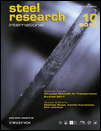Fatigue Behavior of Dual-Phase and TWIP Steels for Lightweight Automotive Structures
Abstract
Car bodies are increasingly made with high-strength steels, for both lightweighting and safety purposes. Steel sheets, made by continuous casting, hot rolling, cold rolling, and continuous heat treating, are used to deep draw the car body parts, which are then joined by resistance spot welding (RSW). Two high-strength automotive steels, with similar tensile strength, are studied here. The low alloy, dual-phase steel consist of ferrite and martensite, obtained by an intercritical heat treatment, followed by fast cooling. The innovative, high-Mn TWIP steel exhibits a promising combination of strength and toughness, arising from the austenitic structure, strengthened by C, and from the twinning induced plasticity effect. Tensile specimens are fatigue tested at room temperature with zero load ratio, both in the as-fabricated (unnotched) condition and after the RSW of an homologous sheet square. Moreover, pre-cracked compact tension specimens are tested with load ratio 0.1 to determine the fatigue crack growth behavior. These results are completed with crystallographic, microstructural, tensile, and fractographic examinations, and the influence of the microstructure and of the welding process is discussed.




